Lyons W.C. (ed.). Standard handbook of petroleum and natural gas engineering.2001- Volume 1
Подождите немного. Документ загружается.

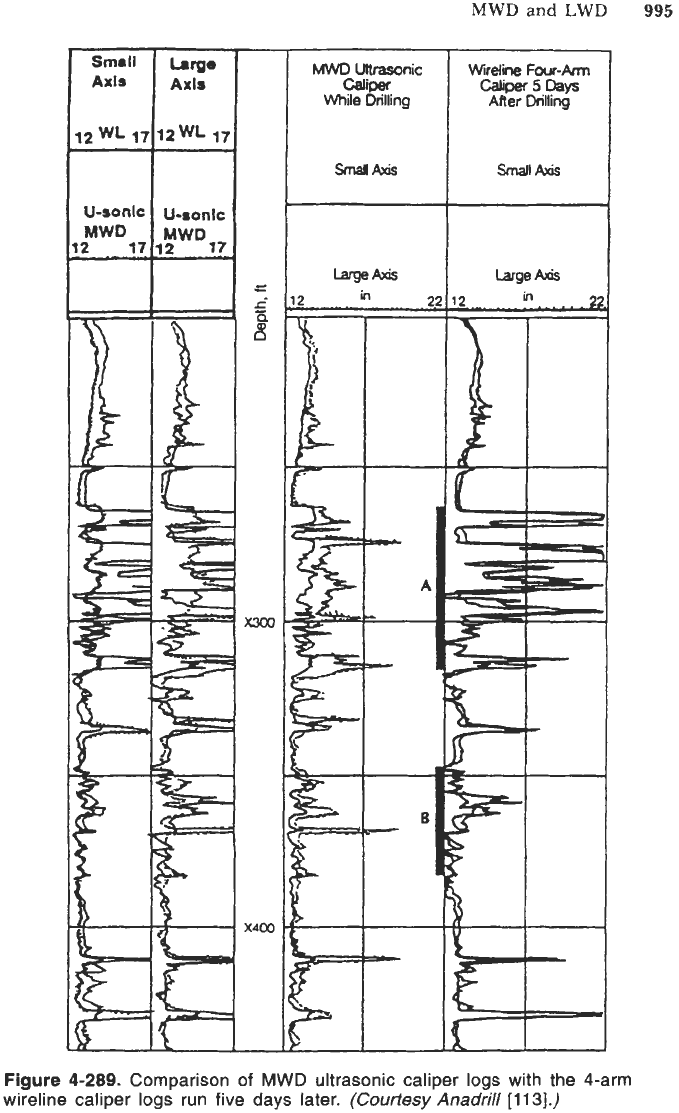
MWD
and
LWD
995
MWD
Uthsonic
Wiretii
Four-Arm
While
Dnlling
After
Drilling
cB"pec
caliper
5
Days
SmalAWis
Small
his
Large
Axis
Figure
4-289.
Comparison
of
MWD
ultrasonic caliper
logs
with the 4-arm
wireline caliper
logs
run five days later.
(Courtesy
Anadrill
[113].)
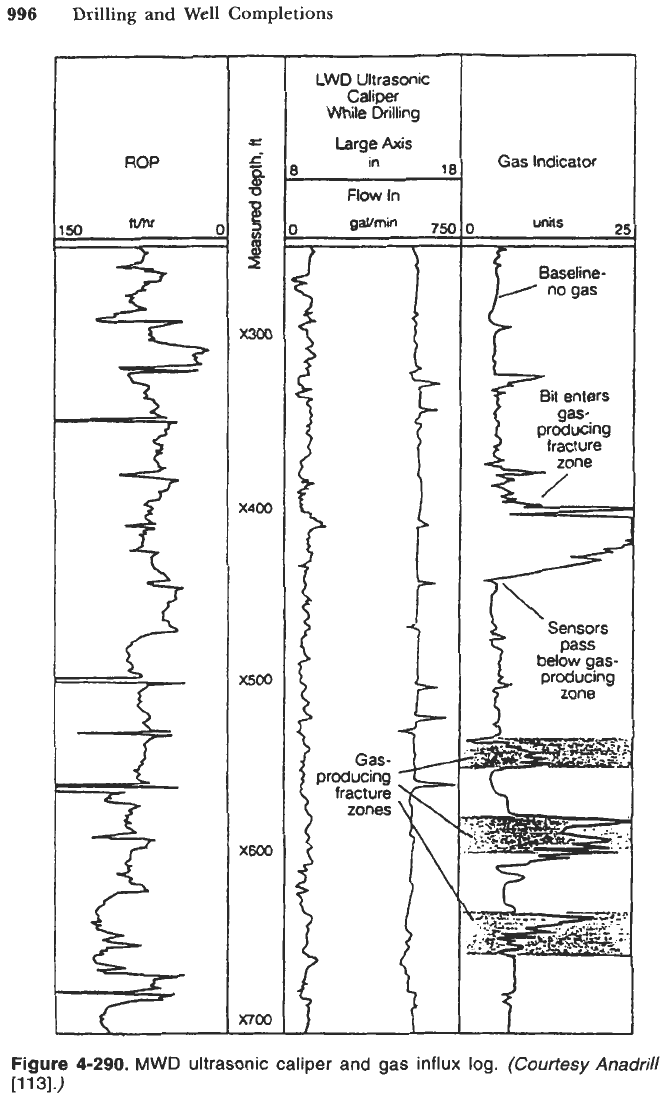
996
)
Drilling and Well
Completions
9*m
7s
i-
1
F
Gas-
producing
fracture
zones
ROP
LWD
Ultrasonic
Caliper
While Drilling
Large
Axis
in
11
I
Flow
In
Gas
Indicator
Baseline-
producing
fracture
zone
Sensors
below
gas-
producing
zone
4
I
Figure
4-290.
MWD
ultrasonic caliper and gas influx log.
(Courtesy
Anadrill
[1131.)

MWD and LWD
997
Standard/
mandrel
battery
Electronics
-
/
Readout
Port
/
Transmitter
6
5/8-in.
FH
7
tool
joint
23.08
ft
6
5/8-in.
FH
tool ioint
Figure
4-291.
Schematic
of
the
LWD
sonic
tool.
(Courtesy
SPWLA
[116].)
For LWD/wireline sonic log comparison, we highlight the zone from
600
to
1000
ft in Figure
4292.
However, the two sonic measurements in the 840-860-ft
interval show
a
major disagreement. This disagreement probably results from
the deteriorated hole condition (two large washouts shown on the caliper logs)
when the wireline logs were acquired
(10
days after drilling).
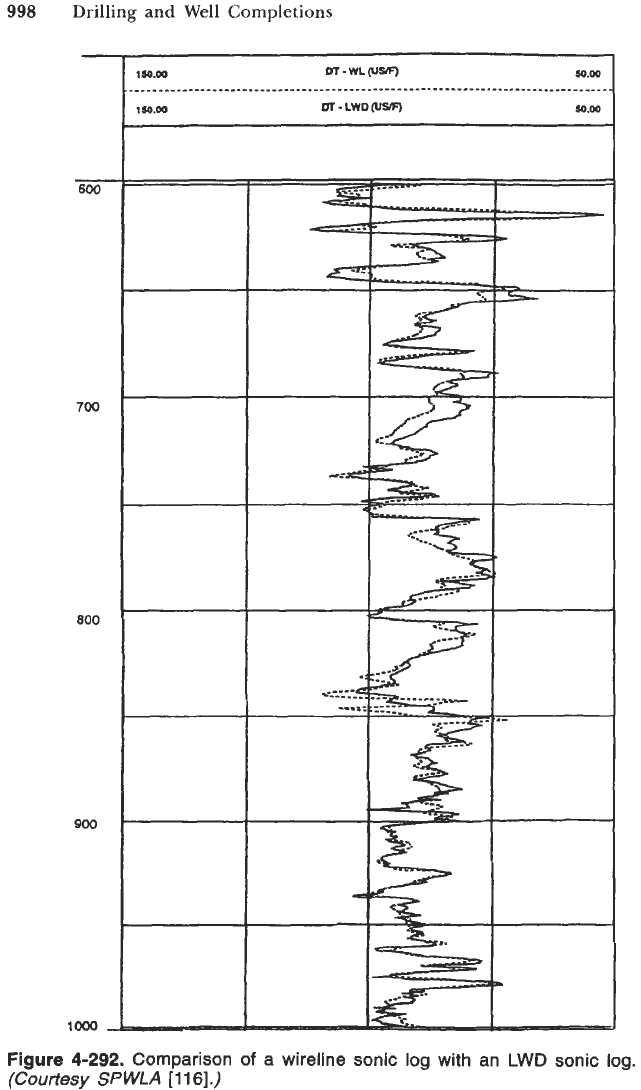
998
Drilling and Well Completions
Figure
4-292.
Comparison
of
a wireline sonic
log
with an
LWD
sonic
log.
(Courtesy
SPWLA
[116].)

MWD and LWD
999
Of particular interest in Figure 4-292 is the shaly sandstone in the 690-720-
ft interval. In this zone, the LWD sonic measurements are consistently faster
than the wireline measurements. Since the wireline logs were acquired 10 days
after drilling, it is likely that shale swelling in the shaly sandstone has taken
place. This phenomenon, known as formation alteration, causes the wireline
sonic measurements to be slower. In this type of zone, LWD sonic yields a more
correct At, which will better match surface seismic sections.
Measuring while Tripping: Wiper Logs
When the MWD systems are battery powered and have a downhole recording capa-
bility or use an electromagnetic telemetry, logging measurements can be repeated
each time the bit is pulled out or run into the borehole. This new capability provides
a way to map the progression of the filtrate front in the permeable formations.
Downhole Recording.
When the logging measurements are battery powered
the logging parameters can be recorded versus time while tripping the drill
string. If the depth is simultaneously recorded versus time, the data can be
plotted versus depth. Common memory capabilities are of the order of
2
to 10
megabytes. The recording rate is adjusted to obtain about two data sets per foot.
Electromagnetic Telemetry.
The electromagnetic telemetry is usually powered
downhole with batteries. Parameters such as gamma ray, resistivity and tem-
perature, can be transmitted while tripping up or down. Since a two-way
communication is possible, the system can be switched to a “logging only” mode
to
transmit only the logging information.
Invasion Diameter Versus Time.
Many parameters determine the invasion
diameter:
formation porosity
formation permeability
mudcake permeability
mudcake thickness
differential pressure
mud filtrate and formation fluid viscosity
Figure 4-293 shows two typical cases for a l+d, 0.25-in. (6-mm) mudcake, 500
psi (3450 kPa) differential pressure, 20% porosity (a), and 30% porosity (b).
The factor permeability is important only for the low permeabilities, below
1
md. The invasion diameter increases rapidly in the first few days, making the
measurements during tripping particularly significant.
Example
18:
Example of Wiper Logs
Figure 4-294 shows a set of resistivity logs run in a sand-shale sequence
of
the Gulf Coast. We have one wireline dual induction log, one MWD resistivity
log, a wiper-MWD resistivity log and one gamma ray log.
1.
Describe the lithology of this zone.
2.
How do we know that the cleaner zones marked
A
and
B
are permeable?
3.
Compare the invasion for the various logs.
4.
What is the true resistivity of Zone
A
and Zone
B?
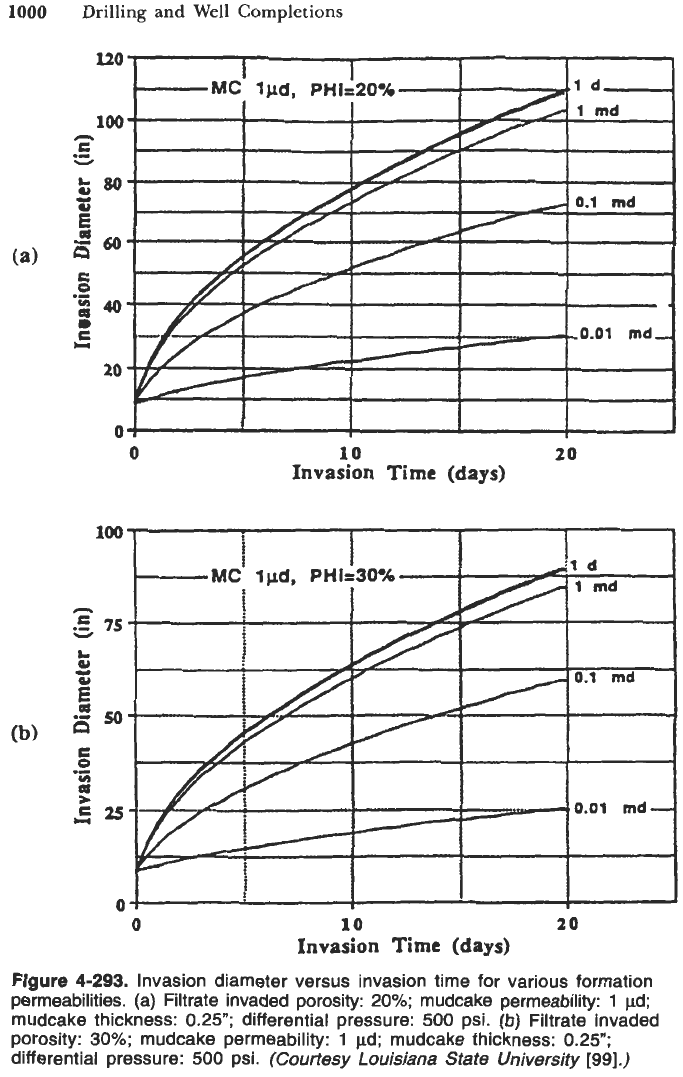
1000
Drilling
and
Well Completions
120
100
n
C
.-
v
r
0
C
.-
;a
h
20
0.1
md
I
u-
0
10 20
Invasion
Time
(days)
VI
0
10
20
Invasion
Time
(days)
Figure
4-293.
Invasion diameter versus invasion time for various formation
permeabilities. (a) Filtrate invaded porosity:
20%;
mudcake permeability:
1
pd;
mudcake thickness:
0.25";
differential pressure:
500
psi. (b) Filtrate invaded
porosity:
30%;
mudcake permeability:
1
pd; mudcake thickness:
0.25";
differential pressure:
500
psi.
(Courtesy
Louisiana
State
University
[99].)
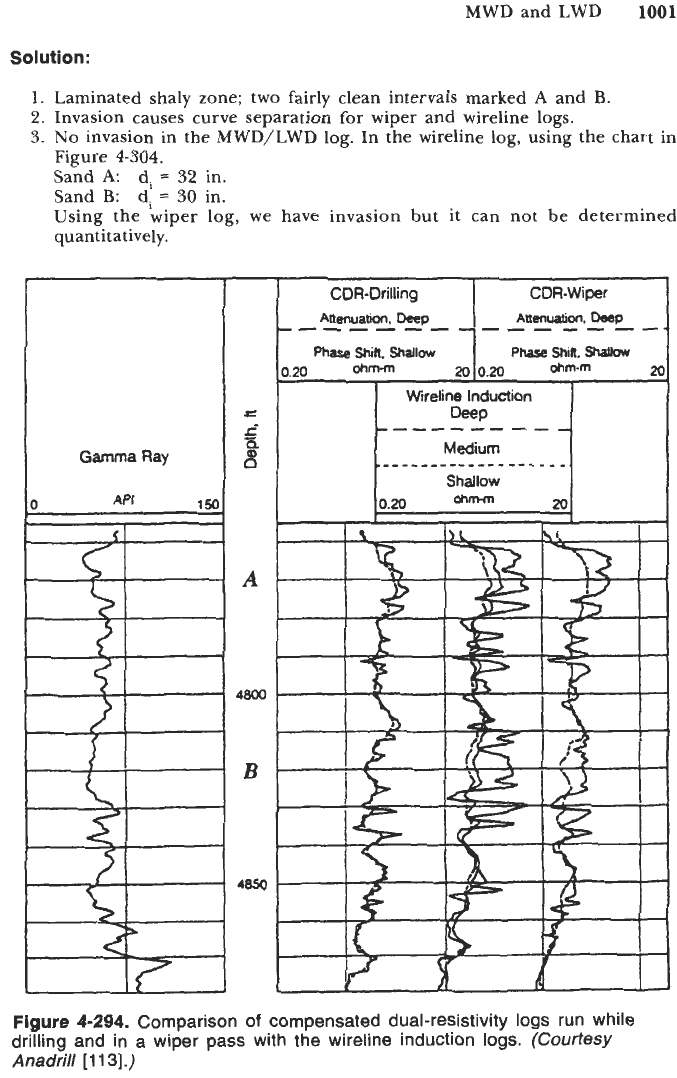
MWD and LWD
1001
Solution:
1.
Laminated shaly zone; two fairly clean intervals marked
A
and
B.
2.
Invasion causes curve separation for wiper and wireline logs.
3.
No
invasion in the MWD/LWD log.
In
the wireline log, using the chart in
Figure
4-304.
Sand
A:
Sand
B:
Using the wiper log, we have invasion but
it
can not be determined
quantitatively.
di
=
32
in.
di
=
30
in.
,
GammaRay
CDR-Drilling COR-Wiper
_-----
-
-
-
-
-
AuewatiOn.DceP-
Auenuatim.DM~-
-
Phase
Shin.
shallow
Phase
Shift.
ShaUow
0.20 *m-m
20
0.20
ohm-rn
20
WP
Wireline
Induction
----------
Medium
Shallow
.______--------
-----
Figure
4-294.
Comparison
of
compensated dual-resistivity logs run while
drilling and in
a
wiper
pass
with the wireline induction logs.
(Courtesy
Anadrill
[
1
1
31
.)
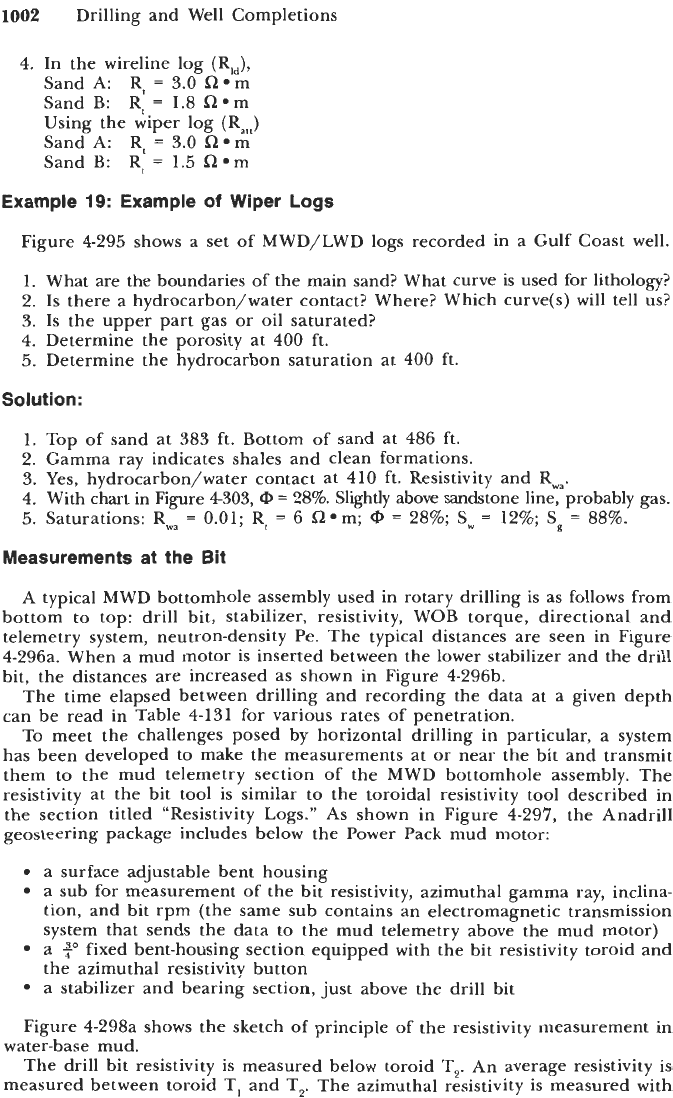
1002
Drilling and Well Completions
4. In the wireline log (R,J,
R,
=
3.0 l2.m
RL
=
1.8
l2.m
Rl
=
3.0
l2.m
R,
=
1.5
8.m
Sand A:
Sand
B:
Using the wiper log (RJ
Sand
A:
Sand B:
Example
19:
Example
of
Wiper
Logs
Figure 4-295 shows a set of MWD/LWD logs recorded in a Gulf Coast well,
1.
What are the boundaries
of
the main sand? What curve is used for lithology?
2.
Is
there a hydrocarbon/water contact? Where? Which curve(s) will tell
us?
3.
Is the upper part gas or oil saturated?
4. Determine the porosity at 400 ft.
5.
Determine the hydrocarbon saturation at 400 ft.
Solution:
1. Top of sand at 383
ft.
Bottom of sand at 486 ft.
2. Gamma ray indicates shales and clean formations.
3.
Yes, hydrocarbon/water contact at 410 ft. Resistivity and
Rwa.
4.
With chart in Figure 4303,
Cg
=
28%. Slightly above sandstone line, probably gas.
5.
Saturations:
Rwa
=
0.01:
Rt
=
6
nom;
@
=
28%;
Sw
=
12%;
Sg
=
88%.
Measurements at the
Bit
A
typical MWD bottomhole assembly used in rotary drilling is as follows from
bottom to top: drill bit, stabilizer, resistivity, WOB torque, directional and
telemetry system, neutron-density Pe. The typical distances are seen in Figure
4-296a. When a mud motor is inserted between the lower stabilizer and the drill
bit, the distances are increased as shown in Figure 4-29613.
The time elapsed between drilling and recording the data at a given depth
can be read in Table 4-131 for various rates of penetration.
To meet the challenges posed by horizontal drilling in particular, a system
has been developed to make the measurements at or near the bit and transmit
them to the mud telemetry section of the MWD bottomhole assembly. The
resistivity at the bit tool is similar to the toroidal resistivity tool described in
the section titled “Resistivity Logs.”
As
shown in Figure 4-297, the Anadrill
geosteering package includes below the Power Pack mud motor:
a surface adjustable bent housing
9
a
sub for measurement of the bit resistivity, azimuthal gamma ray, inclina-
tion, and bit rpm (the same sub contains an electromagnetic transmission
system that sends the data to the mud telemetry above the mud motor)
a fixed bent-housing section equipped with the bit resistivity toroid and
the azimuthal resistivity button
a stabilizer and bearing section, just above the drill bit
Figure 4-298a shows the sketch of principle of the resistivity measurement in
water-base mud.
The drill bit resistivity is measured below toroid T,. An average resistivity
is
measured between toroid
T,
and T,. The azimuthal resistivity is measured with
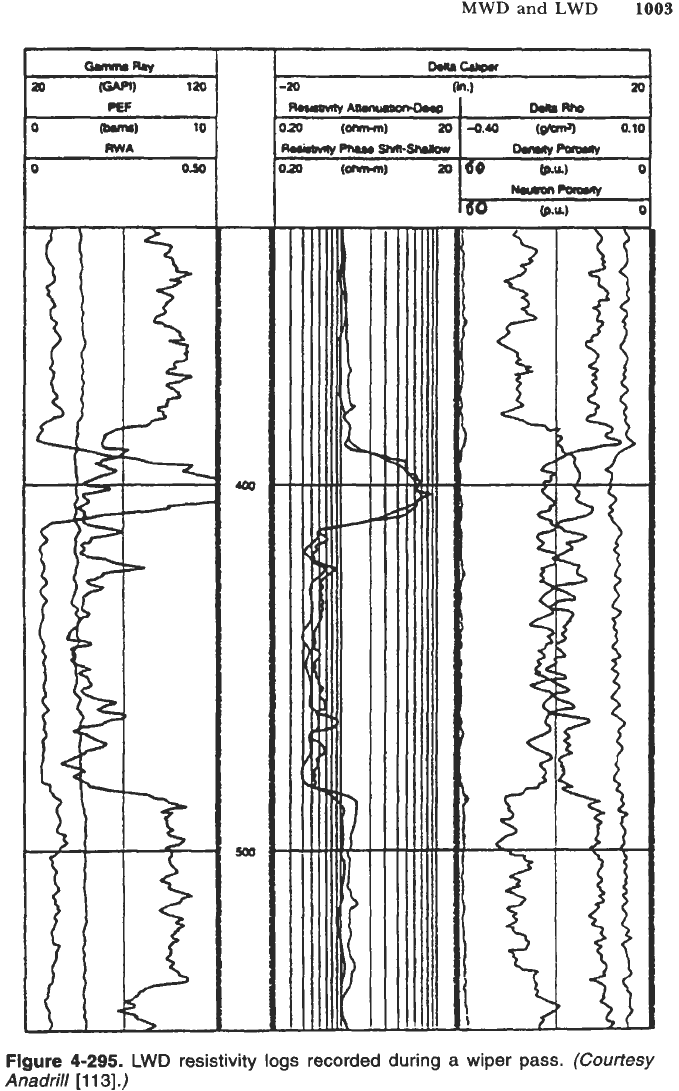
MWD
and
LWD
1003
Qso
i
i
f
L
?
3
5
?
b
>
?
Figure
4-295.
LWD
resistivity logs recorded during a wiper pass.
(Courtesy
Anadrill
[
11
31.)
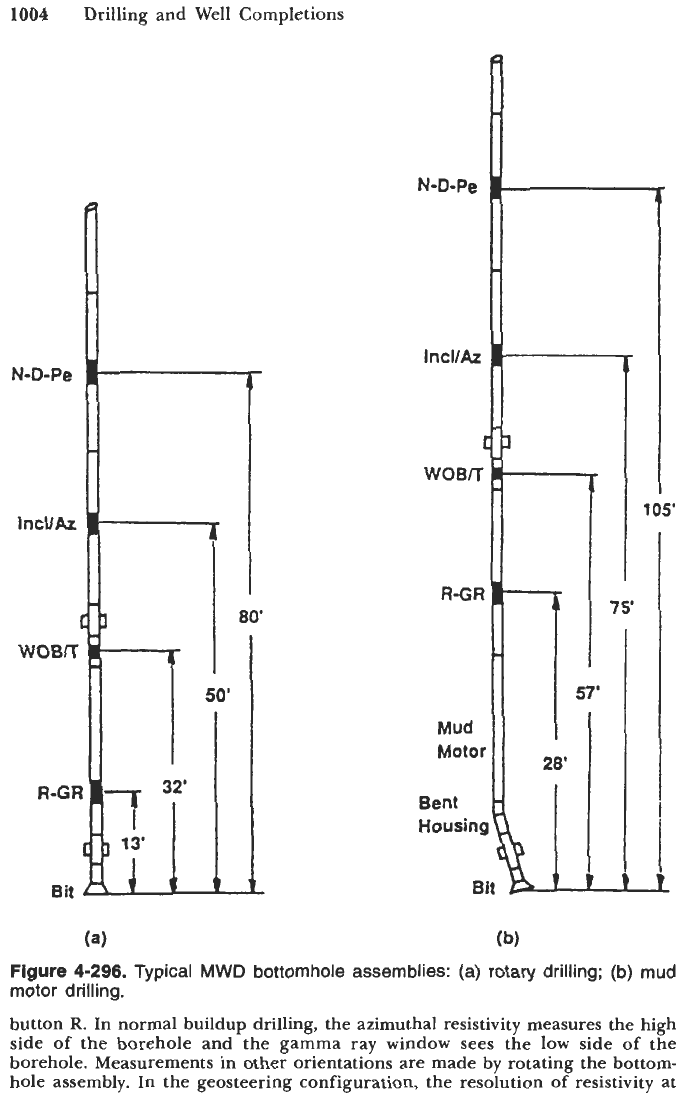
1004
Drilling and Well Completions
WOBK
y
-
1
R-GR
I
F
-
57'
Mud
Motor
28,
Bent
-
?
105'
75'
Figure
4-296.
Typical
MWD
bottomhole assemblies: (a) rotary drilling; (b) mud
motor drilling.
button
R.
In normal buildup drilling, the azimuthal resistivity measures the high
side
of
the borehole and the gamma ray window sees the low side of the
borehole. Measurements in other orientations are made by rotating the bottom-
hole assembly. In the geosteering configuration, the resolution of resistivity at
